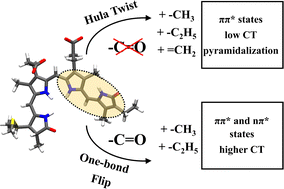Photoisomerization of phytochrome chromophore models: an XMS-CASPT2 study†
Abstract
Phytochromes are a superfamily of photoreceptors that harbor linear tetrapyrroles as chromophores. Upon light illumination, the linear tetrapyrrole chromophore undergoes a double bond isomerization which starts a photocycle. In this work, we studied the photoisomerization of chromophore models designed based on the C- and D-rings of the phycocyanobilin (PCB) chromophore. In total, five different models with varying substitutions were investigated. Firstly, the vertical excitation energies were benchmarked using different computational methods to establish the relative order of the excited states. Based on these calculations, we computed the photoisomerization profiles using the extended multi-state (XMS) version of the CASPT2 method. The profiles were obtained for both the clockwise and counterclockwise rotations of the C15![[double bond, length as m-dash]](https://www.rsc.org/images/entities/char_e001.gif) C16 bond in the Z and E isomers using a linear interpolation of internal coordinates between the Franck–Condon and MECI geometries. In the minimal chromophore model that lacks the substitutions at the pyrrole rings, the isomerization involves both C14–C15 and C15
C16 bond in the Z and E isomers using a linear interpolation of internal coordinates between the Franck–Condon and MECI geometries. In the minimal chromophore model that lacks the substitutions at the pyrrole rings, the isomerization involves both C14–C15 and C15![[double bond, length as m-dash]](https://www.rsc.org/images/entities/char_e001.gif) C16 bonds of the methine bridge between the C- and D-rings, resembling the hula-twist motion. The MECIs are characterized by a partial charge transfer between the two pyrrole rings pointing towards a twisted intramolecular charge transfer. Systematic introduction of substituents leads to an increase in the steric repulsion between the two pyrrole rings causing a pretwist of the dihedral around the C15
C16 bonds of the methine bridge between the C- and D-rings, resembling the hula-twist motion. The MECIs are characterized by a partial charge transfer between the two pyrrole rings pointing towards a twisted intramolecular charge transfer. Systematic introduction of substituents leads to an increase in the steric repulsion between the two pyrrole rings causing a pretwist of the dihedral around the C15![[double bond, length as m-dash]](https://www.rsc.org/images/entities/char_e001.gif) C16 bond, which creates a preference for the counterclockwise isomerization. An introduction of the carbonyl group at the D-ring increases the extent of charge transfer which changes the isomerization mechanism from hula-twist to one-bond flip.
C16 bond, which creates a preference for the counterclockwise isomerization. An introduction of the carbonyl group at the D-ring increases the extent of charge transfer which changes the isomerization mechanism from hula-twist to one-bond flip.

- This article is part of the themed collections: 2022 PCCP HOT Articles and PCCP 2021 Emerging Investigators


 Please wait while we load your content...
Please wait while we load your content...